Gray walls in the interior: beautiful shades and design options
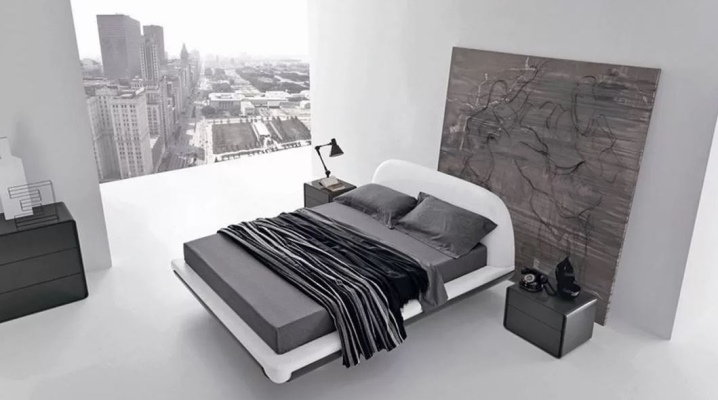
Gray is traditionally perceived as rather boring and devoid of cheerfulness, therefore, for centuries, if it was used in interior design, it was more out of necessity, and not due to a whim.

Another thing is that today all more or less standard solutions have become boring to society, and there is a demand for non-standard approaches in design, so some creative people began to pay attention to gray tones. It should be admitted that the designers quickly grasped the new trend and worked carefully to ensure that dullness was no longer perceived as something negative. Therefore, today this color is no longer perceived worse than any others.






Variety of shades
The neglect of gray in interior design is largely due to the fact that many people do not understand what the richness of its tones and shades really is.
The famous work says that there are fifty of them, however, modern designers will tell you that in fact there are at least several hundred different gray tones. And this applies only to achromatic, that is, just gray, without foreign impurities - mouse, "London fog", graphite and the like. At the same time, the so-called chromatic shades, which are inherent in the ebb of a certain other color, also belong to the gray scale, for example, a very pale version of lilac raises doubts as to which color it really is - lilac or still gray.
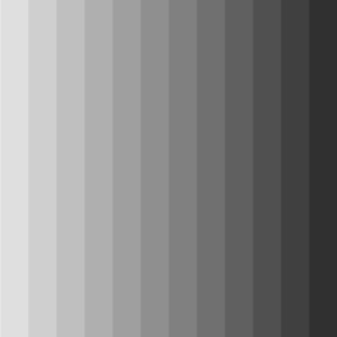

Such a variety allows you to make in its own way bright and not too monotonous, even a room that is designed entirely in gray tones.
At the same time, many modern styles are not only not afraid to exploit such color schemes, but also emphasize them, which will be discussed in more detail below.
Accordingly, a large number of shade options allows you to use gray not only to decorate a room in accordance with your own tastes, but also to visually correct its size or change its emotional perception. So, light colors tune in a more positive way, they are not perceived as dullness, but at the same time they are quite strict and allow you to concentrate. They seem to expand the space of a cramped room and add lighting where natural light usually does not get in large quantities. Dark shades of gray are used a little less often, since they can put pressure on the psyche, but in general they are appropriate in a situation where the room is already too light, and its dimensions are also too large.






Combination with other colors
Despite the fact that modern designers very often praise gray as a good solution, they themselves rarely decide to use it without any extraneous additions in the form of inserts of a different color. Indeed, gray shades can be the main ones in the room, however, the overall grayness should be diluted with some brighter colors, certain accents should be emphasized... Fortunately, grays tend to work well with just about any other color, as grays, being a mixture of neutral whites and blacks, are also neutral.




In many cases, when the atmosphere of the room requires not so much brightness as exposure and concentration in a positive way, white and beige can be a good company for gray. These shades tune in to the positive and add light to the room, but at the same time they do not draw attention to themselves, and can be emphasized by the general grayish design. With the same black, for example, the situation is more complicated - you may get the impression that the atmosphere in the room is too gloomy and even oppressive, so this combination is already used more carefully, trying to choose the lightest shades of gray.
On the other hand, in a black and gray combination, you can simply add some red accents, and then the whole design will be perceived completely differently.



The soft shades of blue and green themselves are already close to gray, but against its background they suddenly acquire a completely different play of colors and become bright accents. It is not even necessary to choose the brightest solutions like underlined pearl and blue - if you like such solutions, it may not make sense to choose a gray background. At the same time, even pale versions of these colors will harmonize perfectly with gray walls and create a sudden feeling of coziness.




Yellow is one of the most cheerful colors, it reminds of summer and warmth, therefore it is often used in combination with gray.
In this case, it is important to choose the most "sunny" shades, which on a relatively plain background will seem much more expressive. Occasional inserts of gold, even if it's just the name of the tone, will make the interior refined, but combinations with a darker brown are quite risky - despite the fact that it is warm and natural, it will add gloom to the room.


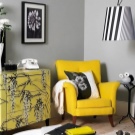



The combination of gray with pink may seem strange to most people in interior design, but this decision is not at all bad if you choose muted pink tones close to chromatic gray.
This will make the overall dullness of the room warmer and softer, due to which the room will definitely not be perceived as gloomy.



Finishing options
Modern finishing materials of various types successfully exploit the gray color theme. The most popular option, as in any other color schemes, remains wallpaper - they are good for their ability to hide minor imperfections of the walls, while they can differ in a pleasant texture and texture. To an inexperienced person, this may seem strange, but there are even gray photowall-paper - on them the same city landscapes can be transferred in monochrome. Alternatively, liquid wallpapers are also used, which are more expensive, but are most productive in terms of hiding minor wall defects.



Gray color is very characteristic of the loft style, and the latter is very fond of uncovered brick in the form of a finishing material. Of course, today, in most cases, brickwork is a purely decorative element, the wall under it can also be made of blocks, while it is only decorated with small pieces of real bricks. There are also initially gray bricks, but much more often they are simply painted in this color.



Paint is perhaps the cheapest way to update the interior of a room, so it enjoys a well-deserved and well-founded popularity. Most often, ideally flat, pre-plastered walls are finished with it, but in fact, the lining can also be painted, which will give the interior a somewhat unusual flavor and will extend the life of the old wooden finish. Decorative Venetian plaster is a rather expensive solution, but interesting for its texture. Like wallpaper, such material skillfully hides small cracks and damage to walls, and therefore, in some cases, preliminary surface preparation is not even required.
In some styles, this design decision seems even very appropriate.



Finally, we will briefly mention a few more materials that are used much less often for wall decoration in gray, but can still be a detail of an unusual interior.These include tiles, wall panels, decorative stone and even laminate flooring.
Style selection
Many people still think that grayscale design is an example of tastelessness, however, in fact, this, of course, is not true. So that you have no doubts, consider four main styles that intensively use the gray scale, and without its representatives somehow do not even fit into the head.
- Loft - the king of gray, it is possible that it was he who popularized the gray walls in modern society. Initially, premises in this style were rebuilt into residential ones from production facilities, so the boring factory interior is easy to explain. At the same time, the tenants showed a creative approach to add bright colors to their apartment, and saw a certain romance in their new housing, which is why many fell in love with the loft. Please note that the presence of bright colors is not prohibited, and even encouraged, but the base is still strictly gray and careless, without excessive accuracy.




- Scandinavian style - an example of thoughtfulness and strict practicality, sometimes the thought even creeps in that all interior items are not painted in any bright color simply because it would have come out more expensive. At the same time, such an interior is not purely gray, it would be more correct to call it gray and white. The emphasis in decoration and furnishings is made on natural materials, while blotches of "foreign" colors are possible, but they are usually not enough to call them full-fledged accents.




- The so-called modern style usually very reminiscent of minimalism - unlike the same Scandinavian, where everything is purely practical, here, in general, a minimum of attention is paid to dispensing with various additional details. Absolutely even monochromatic gray walls with a smooth texture are ideally combined with all other furnishings, sustained in exactly the same vein, the whole play of colors is provided mainly by shades of the same gray, and with bright accents it is an outright disaster. However, for focused people, this is exactly what you need.
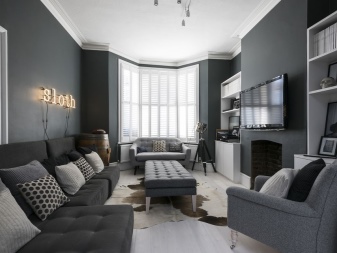

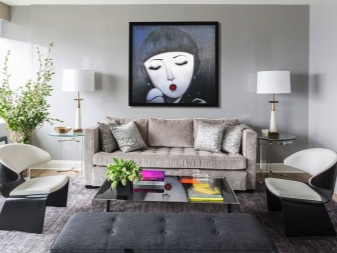

- Classic for some reason, it is perceived as a style in which gray shades are not inherent, but this is sheer nonsense - in the old days it was gray that was the main color in decoration everywhere, even in royal palaces. If you are focusing on such a design, forget about any modern materials, try to focus on wood, metal and an abundance of textiles. At the same time, decorativeness is achieved due to small decorations such as curly modeling on the walls, portraits, candelabra, and so on.



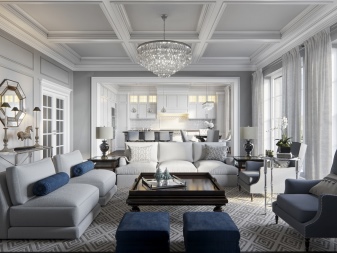
Use in various rooms
Gray walls in the interior of each room have their own characteristics - you need to take into account the specifics of the room so that dullness is not perceived as a negative. Traditionally, the best place for gray walls is the kitchen. This is the most technologically advanced part of the apartment, it is literally crammed with various equipment, and the brilliant light shades of gray seem appropriate here.
In this room, it is permissible to make absolutely everything gray - curtains, doors, and the floor, but as an accent, you can use either a wall with photo wallpaper, or fresh flowers, or colored chairs.

In the bedroom, the gray tone should almost certainly be diluted with either white or pastel shades in order to soften the atmosphere somewhat and fall asleep in a good mood. Here, perhaps, like nowhere else, you need to pay attention to the chromatic variants of the gray tone. The furniture in this room, like the walls, may well be gray, but it is recommended to pay more attention to the texture, since in a fleecy or rough design it gives a little more comfort.

A living room in purely gray tones is, frankly, overkill. The tenants of the apartment themselves and their guests come here to relax and unwind together. The hall involves communication between those present, and in a too gray environment for this, there may be no mood. For this reason, the walls of the living room may well be gray, but it is very important to add more bright accents.


A bathroom in a minimalistic gray design is a rather popular solution, but the main disadvantage is that the main shade is cold. Swimming in water when its temperature subconsciously seems low is not a test for everyone.

For a children's room, gray wall decoration often seems unacceptable as too boring, but in the chromatic design, everything may not be so bad, and this will even help calm an overly active baby.
At the same time, the gray color should be combined with an abundance of bright furnishings, which against the background of the walls will seem even more attractive.

As for the hallway, outstanding decor is usually not required here, so a gray color scheme seems like a good idea. At the same time, do not forget that natural light penetrates here minimally, so it is better to choose light shades. In addition, the room should not create a gloomy impression, because it accompanies you on all your hikes outside, and greets you when you finally had to get into a friendly atmosphere.

Successful examples
The first example clearly shows that the gray walls in the living room are far from a vice, if you correctly dilute them with catchy color accents. In this case, the colors are selected from among the rare ones - cheerful yellow and unusual violet are the company of gray, which provides a rather pleasant and non-standard result. A real fire in the fireplace and wood installations above it finally disperse the cold that such dullness could bring.

The second photo shows how chromatic tones can blend into a cozy bedroom. Here, the walls are gray only in a very general sense of the word - any artist or other professional who is directly related to shades and colors would probably try to describe the tone in some more complex term. It was decided to dilute the nondescript gamut with red inserts, which are usually considered too aggressive for the bedroom, but here most of them in the supine position simply do not enter the field of view, so they do not interfere.

And this is how a kitchen can look if you try to combine modern manufacturability and suddenly natural wooden inserts in its features. This style is not easy to define with a specific term, but it came out very fresh and non-trivial.

For an overview of an apartment with gray walls, see the next video.













The comment was sent successfully.